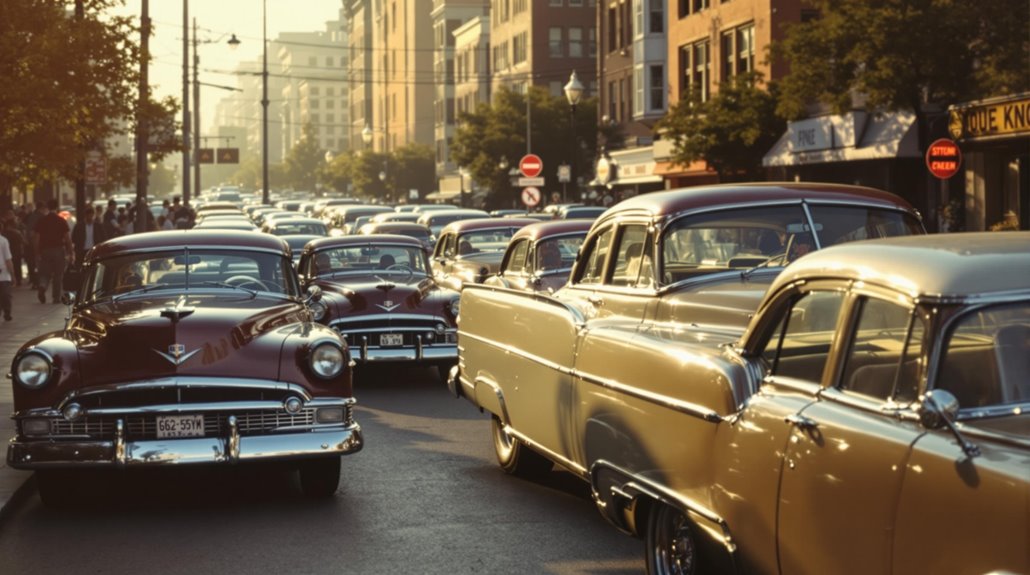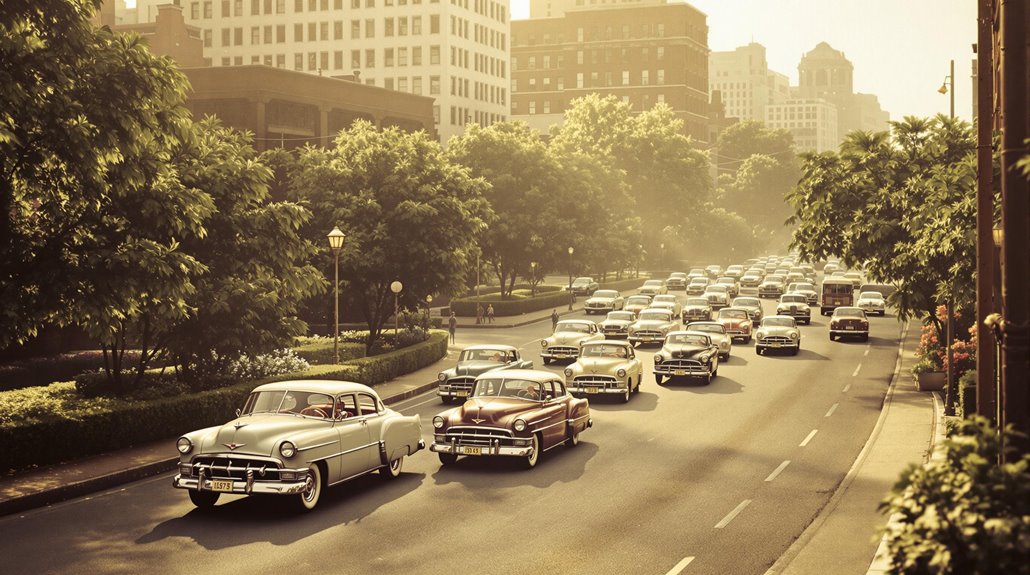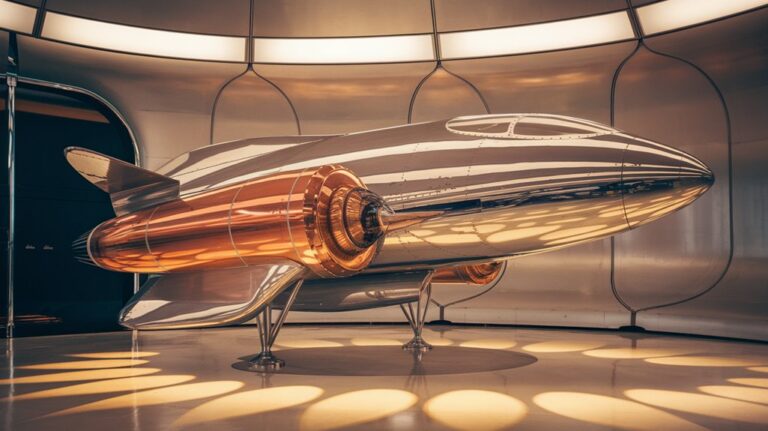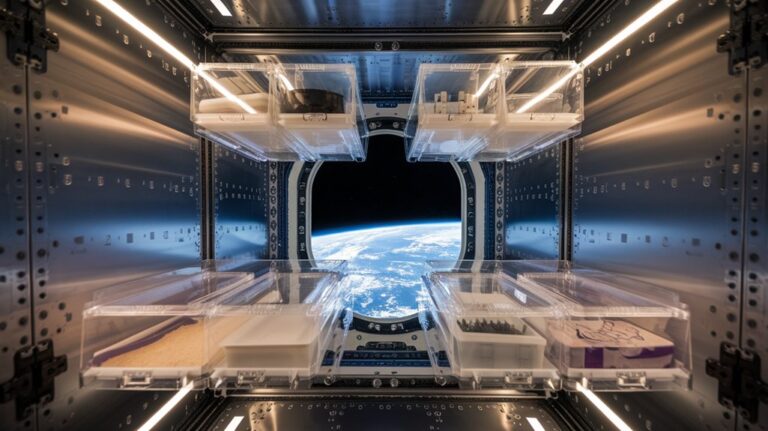Jetpack Dreams: Why We’re Still Stuck in Traffic
You've probably imagined yourself zipping through the air in a personal jetpack, bypassing the sea of brake lights below. Yet here you are, inching forward in rush hour traffic just like everyone else. While science fiction promised us flying cars and aerial commutes by 2023, our transportation reality remains firmly grounded—and gridlocked. The gap between our soaring ambitions and earthbound constraints reveals important lessons about the future of urban mobility.
The Promise vs. Reality of Modern Transportation

While science fiction writers once imagined we'd all have personal jetpacks by now, today's transportation reality looks quite different.
You'll find that instead of flying through the skies, we're focusing on making ground transportation smarter and cleaner. Similar to how the Intel Xeon 5600 processors revolutionized energy efficiency, modern transport systems prioritize sustainability and performance optimization. Autonomous vehicles promise to slash accidents by 90% and optimize traffic flow, yet you're still likely to encounter congestion during your daily commute. Despite confident claims, past failed promises from industry leaders have made the public increasingly skeptical of revolutionary transport solutions.
Electric transportation is making strides, from Tesla's semi-trucks to cargo bikes in urban centers, but widespread adoption faces persistent hurdles.
While you might dream of zipping between cities at 600 mph in a hyperloop pod, you're more likely to see incremental improvements in existing systems.
The future of transport isn't about personal flying devices – it's about reimagining how you move through increasingly crowded spaces more efficiently and sustainably.
Breaking Down Today's Traffic Crisis
Despite advances in vehicle safety technology, traffic fatalities continue to surge across the nation, with over 21,400 deaths recorded in just the first half of 2025.
You're now more likely than ever to encounter dangerous driving conditions, as vehicle miles traveled jumped by 215 billion miles during this period. The increasing traffic congestion isn't just an inconvenience – it's deadly.
While urban planning experts analyze data from tools like the TomTom Traffic Index to improve safety, you're facing multiple threats on the road. A striking example is Mexico City, where congestion rates exceed 52% during peak hours.
Each day brings an average of 116 deaths from traffic accidents across America, highlighting the urgency of implementing new safety measures. Distracted driving, speeding, and aggressive behavior have become commonplace, especially in major cities like Los Angeles, where someone dies every 32 hours.
Though initiatives like Vision Zero aim for zero fatalities by 2050, the current $400 billion annual economic toll from crashes demands immediate solutions.
Remote Work's Double-Edged Impact
As remote work transforms the modern workplace, its impact on traffic patterns reveals a complex story of success and challenge.
You'll find dramatic variations across cities: while Raleigh and San Diego saw significant congestion drops alongside increased remote work, places like Tucson and Columbia experienced worsening traffic despite their work-from-home surge.
The environmental stakes are substantial – a 10% reduction in onsite workers could slash CO2 emissions by nearly 192 million metric tons annually.
However, you're looking at a potential transit crisis, with the same decrease threatening 2.4 billion fewer transit trips and $3.7 billion in lost fare revenue.
Despite a 33% drop in remote work, San Jose exemplifies the continuing evolution of workplace flexibility.
Cities like New York still top congestion charts, proving that remote work isn't a universal solution.
Transit agencies must now reimagine their services for an increasingly flexible workforce.
In the Midwest, Omaha's finance sector demonstrated remarkable success with congestion dropping 29% as remote work adoption surged.
The Hidden Costs of Gridlock
Beyond the visible frustration of sitting in traffic, gridlock inflicts staggering economic wounds across America's transportation networks.
You're not just losing time – the economic consequences ripple through every sector, with the trucking industry alone hemorrhaging $108.8 billion in 2022. That's equivalent to parking 22% of America's licensed truck drivers for an entire year.
The impact extends far beyond your wallet. While you're idling in traffic, you're burning through 6.4 billion gallons of wasted fuel, releasing 65.4 million metric tons of CO2 into the atmosphere. Fine particulate matter from idling vehicles poses serious health risks to communities near highways.
Urban planning challenges multiply as cities dedicate more space to parking instead of community development. The hidden toll includes increased stress levels, compromised emergency response times, and reduced economic activity in city centers – proving that gridlock's true cost can't be measured in dollars alone. This burden has grown even heavier as truck operational costs jumped 21.6% in 2022, reaching $90.78 per hour.
Smart Solutions for Smarter Cities

While gridlock continues to plague our cities, innovative smart traffic management systems are revolutionizing urban mobility. Through sophisticated data integration and a network of traffic sensors, you'll experience shorter commute times and safer journeys as AI-powered systems optimize traffic flow in real-time. Modern traffic management utilizes machine learning algorithms to identify patterns and optimize solutions.
These intelligent systems deliver three key advantages:
- Adaptive traffic signals that automatically adjust to congestion patterns
- Real-time incident detection and emergency response coordination
- Personalized route recommendations based on current conditions
You'll notice the difference as these smart solutions work behind the scenes, monitoring and managing traffic patterns 24/7. The implementation of high-speed fiber networks provides the essential infrastructure backbone for these advanced traffic management solutions.
While implementation challenges exist, including network infrastructure requirements and privacy concerns, the benefits are clear: reduced congestion, improved air quality, and enhanced safety for everyone on the road.
Where Do We Go From Here: The Road Ahead
What lies on the horizon for urban transportation?
You'll soon see a transformation in future mobility that combines innovative infrastructure with cutting-edge technology. Smart cities will integrate autonomous vehicles with dedicated BRT lanes, while V2V communication systems keep traffic flowing smoothly. Lost productivity costs from traffic congestion continue to burden businesses and communities.
 USD 277 billion annually through improved traffic management.
USD 277 billion annually through improved traffic management.
Urban design will evolve to prioritize pedestrians and cyclists, with elevated skyways and underground tunnels reducing surface congestion.
You'll benefit from mixed-use developments that shorten commute distances, while congestion pricing helps manage traffic flow.
Whether you're sharing an autonomous vehicle or riding a bike through dedicated lanes, transportation solutions are becoming more sustainable and efficient.
The future isn't about single solutions – it's about creating an interconnected system that works for everyone.










